Table of Contents
MULTICULTURAL MOONS: TURTLES, DRAGONS, AND MOON CAKES
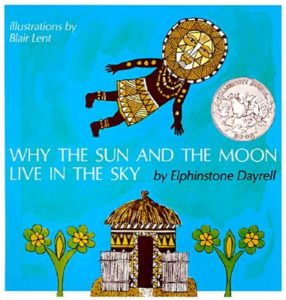
|
Elphinstone Dayrell’s Why the Sun and Moon Live in the Sky (Sandpiper, 1990) is a picture-book version of an African folktale in which husband and wife Sun and Moon build a big house in anticipation of a visit from Water. It’s not big enough: when Water and all his friends come to visit, the house fills to overflowing, forcing Sun and Moon to flee to the sky where they have lived ever since. For ages 4-8. |
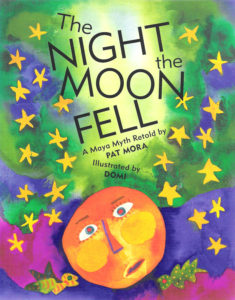
|
Pat Mora’s The Night the Moon Fell (Groundwood Books, 2009) is a picture-book version of a Mayan folktale in which a blowgun shot startles the moon, causing her to lose her balance, fall from the sky, and break into pieces. Scattered on the ocean floor, the moon – with help from some friendly fish – manages to put herself together again, and the fish return with her to the night sky and become the Milky Way. For ages 3-7. |

|
In Thirteen Moons on Turtle’s Back by Joseph Bruchac and Jonathan London (Puffin, 1997), the thirteen scales on Old Turtle’s back represent, in Native American lore, the thirteen lunar months of the year. The book has an evocative poem for each lunar moon from the Moon of Popping Trees and Baby Bear Moon through Moose-Calling Moon, Moon When the Wolves Run Together, and Big Moon. Each is illustrated with a lush oil painting by Thomas Locker. For ages 6 and up. |
| Thirteen Moons on a Turtle’s Back has instructions for making a lunar calendar using a printable turtle template. | |
| Make your own cut-and-paste thirteen-scaled turtle. For a printable template, see Cut and Paste Turtle. |
|
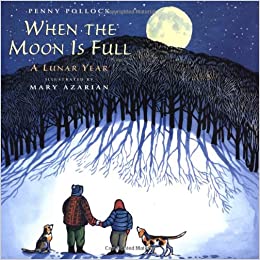
|
Penny Pollock’s When the Moon is Full (Little, Brown and Company, 2001), illustrated with beautiful hand-colored woodcuts by Mary Azarian, has twelve poems for twelve Native American moons from Wolf Moon to Long Night Moon, along with a brief appendix of moon facts. For ages 4 and up. This is regrettably out of print, but is available from libraries, in used editions, and as a Kindle book. |
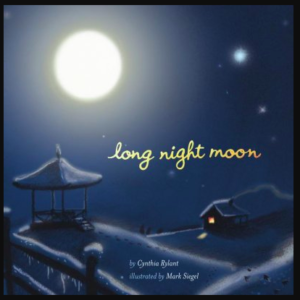
|
Cynthia Rylant’s Long Night Moon (Simon & Schuster Books for Young Readers, 2004) has a poem for each Native American moon of the year, illustrated with lovely moonlit charcoal and pastel landscapes by Mark Siegel. For ages 4-8. |
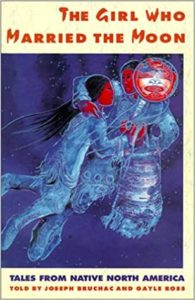
|
The Girl Who Married the Moon by Joseph Bruchac and Gayle Ross (Fulcrum Publishing, 2006) is a collection of 16 native American folktales grouped by region (Northeast, Southeast, Southwest, and Northwest), all on the theme of girls reaching womanhood. The title tale, an Alutiiq legend from Kodiak Island, explains how a young girl married the Moon and eventually came to share his job. We now have two moons: the husband begins each month, wearing a changing moon mask each night until the moon is full; then the wife takes over, wearing the changing masks until the month’s end. For ages 10 and up. |
| This animated version of The Girl Who Married the Moon was made by Kodiak high school students in collaboration with the Alutiiq Museum. | |
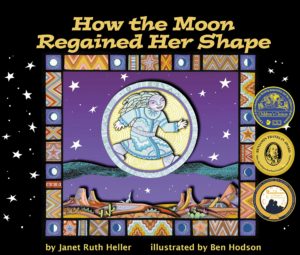
|
Janet Ruth Heller’s How the Moon Regained Her Shape (Sylvan Dell Publishing, 2006) is a Native-American-style tale about bullying. The angry sun calls the moon names (“You ugly scarecrow!”), so the crushed moon vanishes from the sky – until, convinced by the voices of all who love her, including some moonlight-dancing rabbits, she regains her confidence and returns to her rightful place. An appended “Creative Minds” section includes information about moon phases and traditional moon names, a recipe for moon cookies, and a template for making a lunar cycle circle. For ages 5-9. |
| From the Colonial Williamsburg Journal, The Tyme Appointed is an article on the timing of the 17th-century Powhatan Indian alliance attacks on the English settlers. (Were they timed by the moon?) | |
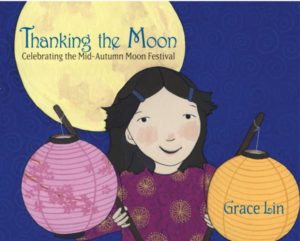
|
Grace Lin’s Thanking the Moon is a simple account of the mid-autumn Moon Festival in which a Chinese-American family – parents and three children – celebrate with a nighttime picnic, moon cakes, a moon-honoring table, glowing paper lanterns, and finally the making of a special secret wish. For ages 3-7. |
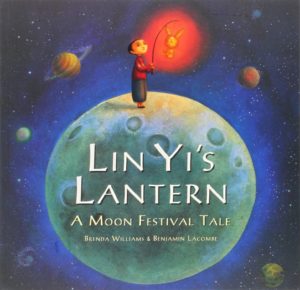
|
In Lin Yi’s Lantern by Brenda Williams (Barefoot Books, 2009), Lin Yi is sent to the market to purchase supplies for the Moon Festival – moon cakes, rice, star fruit, yams, and (for his Uncle Hui) peanuts – but what he wants most of all is a red rabbit lantern for himself. The book is a lovely lesson in thoughtfulness and generosity. Included are instructions for making a Chinese lantern. For ages 4-8. |
| Bake your own moon cakes! | |
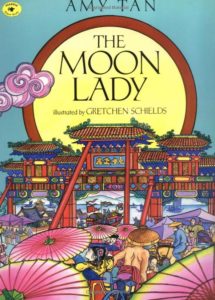
|
In Amy Tan’s The Moon Lady (Aladdin, 1995), three sisters – unhappily trapped indoors on a rainy day – are told a story by their grandmother (Nai-nai) about her childhood when, one Moon Festival evening, she sets off to find the Moon Lady who can grant secret wishes. She has some frightening adventures – among them falling into a lake – until she is finally, gratefully, reunited with her family again. The lesson learned was that the best wishes are those you can make come true for yourself. For ages 8-11. |
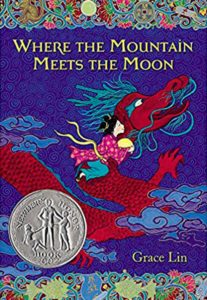
|
In Grace Lin’s Where the Mountain Meets the Moon (Little, Brown Books for Young Readers, 2011), Minli and her parents eke out existence in a mud-colored village in the valley of the Fruitless Mountain, where in the evenings Minli’s father tells her wonderful tales of the Jade Dragon and the Old Man in the Moon. Then Minli spends a precious coin to buy a goldfish, hoping to bring fortune to the family. Instead, the fish is just another mouth to feed, so Minli sets it free. In gratitude, the fish tells her how to find Never-Ending Mountain, the home of the Old Man in the Moon, who knows everything, including the way to make the family’s fortune. Minli’s quest is punctuated with wonderful thought-provoking Chinese folktales – and eventually, though not in the way she had expected, she finds her heart’s desire. For ages 8-12. |
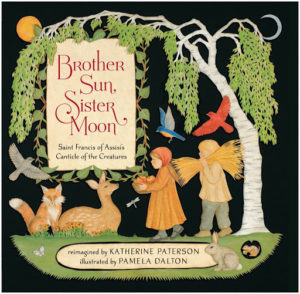
|
Katherine Paterson’s Brother Sun, Sister Moon (Chronicle Books, 2011) is a picture-book version of a hymn of praise (“The Canticle of the Sun”) originally written by Saint Francis of Assisi. The lovely illustrations, by Pamela Dalton, are intricate hand-colored scherenschnitte or paper-cuttings. For ages 4 and up. |
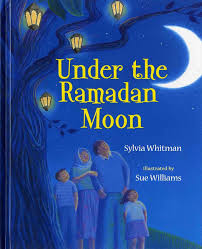
|
In Sylvia Whitman’s Under the Ramadan Moon (Albert Whitman & Company, 2011), a modern Muslim family waits for the first crescent moon that signals the beginning of Ramadan. This is a simple picture-book account of how Ramadan is celebrated, through fasting, prayer, reading of the Qu’ran, and charity to the poor. For ages 4-8. |
| Monday is the Moon’s Day. Find out about the origins of the names of the days of the week here. |
